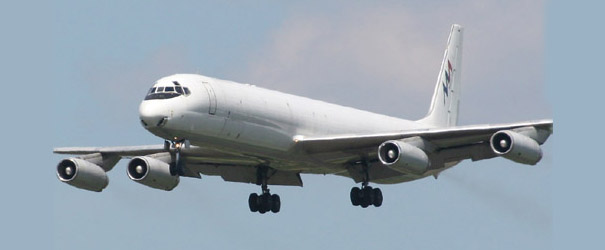
The Douglas DC-8 Super Sixties
Quoting from Wikipedia, “Throughout its production life the DC-8 was often regarded, unfairly, as little more than a copy of the 707, which outsold it by roughly two to one. But in the longer term the DC-8 proved its value. By 2002, of the 1,032 707s and 720s manufactured for commercial use, just 80 remained in service — though many of those 707s wound up converted for USAF use, either in service or for spare parts. Of the 556 DC-8s made, around 200 were still in commercial service in 2002, including about 25 50-Series, 82 of the stretched 60-Series, and 96 out of the 110 re-engined 70-Series. Most of the surviving DC-8s are now used as freighters.”
DC-8
In the first years of flying the DC-8 (search) , it became evident that the 707 (search) had a range advantage which, together with its earlier availability, made the Boeing product the airline market leader. By the early 1960s the DC-8 program was in danger of closing with fewer than 300 aircraft sold. Clearly, something had to be done to increase market share.
At the time, DC-8 performance improvements had been under consideration: A six foot span increase, re-designed engine pylons that attached to the wing’s lower surface only, and modified engine nacelles to duct the fan outflow to the tailpipe, held the promise of substantially lower drag and therefore, better miles per pound of fuel.
Another benefit of the Douglas design that could be exploited was that the DC-8 had been planned to allow the fuselage to be stretched without modifying the landing gear. The 707 fuselage could not have been lengthened as much as the Douglas plane because of limits due to tail strikes (search) during takeoff rotation.
In April, 1965 a decision was made to offer combinations of both the performance improvements and the stretched fuselage with a family of three models tailored for domestic and international routes. Thus was born the DC-8 Super 60 Series.
DC-8-61 - The first model of the series featured the same wing, fuel capacity and JT3D-3B (search) power plant installation as the DC-8-55. The maximum gross takeoff weight remained at 325.000 lbs. The fuselage, however, was stretched 36 ft. 8 in. (240 inches forward of the wing, 200 inches aft). The added cabin length permitted a maximum high-density seating of 259, up from 189 in the earlier standard body models. Cargo holds grew from 1,390 cu ft to 2,500 cu ft allowing for substantial revenue freight beyond the baggage space requirements.
Range of the -61 was adequate for the domestic needs of United, Delta, Eastern, Air Canada, National, and JAL. The plane could carry maximum payloads from New York to Los Angeles and between the West Coast and Hawaii. Seventy eight of this model were delivered.
First flight was accomplished on March 14, 1966.
A convertible passenger - cargo version, the DC-8-61CF, was also offered. With its large main deck cargo door and reinforced floor, ten of the CF planes were built and delivered to Saturn, Trans Caribbean, TIA, and Universal. The longer fuselage allowed for 17% more cubic cargo capacity than Series 50 freighters.
DC-8-62 - To compete more effectively in the long range market, Douglas applied aerodynamic improvements - the 6 ft span increase, the long duct engine pod, and cut back pylons - with a modest fuselage stretch of 6 ft, 8 in (40 inch plugs fore and aft of the wing). Static engine thrust went up to 19,000 lbs with the JT3D-7 engine. Gross weight was raised to 350,000 lbs ( -62H) and fuel capacity was increased to 24,275 gallons. First flight of the -62 was on August 29, 1966.
The increased performance of the -62 permitted scheduled service on the polar route between the U.S. West Coast to Europe, Rome - Buenos Aires, and transpacific flights. Fifty one passenger planes were delivered. In addition, six all freighters and eight convertible freighters were sold.
DC-8-63 - The last model of the family combined the stretched fuselage of the -61 with the performance improvements of the -62. The resulting aircraft was tailored for the major transatlantic routes. After its maiden flight on April 10, 1967, 40 passenger planes were delivered to KLM, SAS, Iberia, Air Canada, Canadian Pacific, and VIASA.

